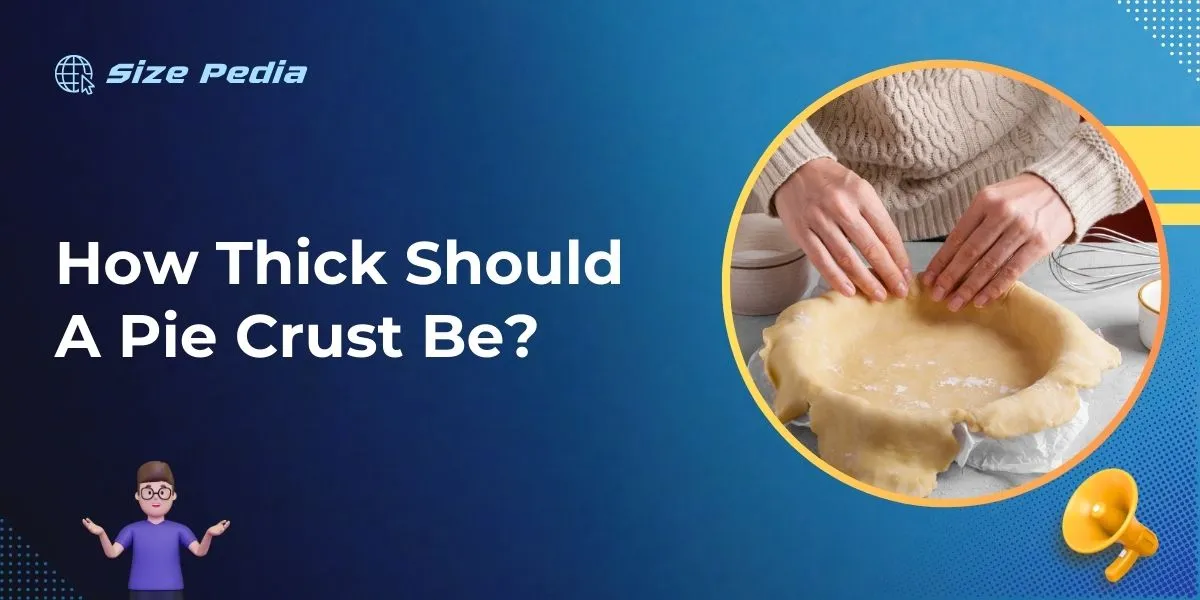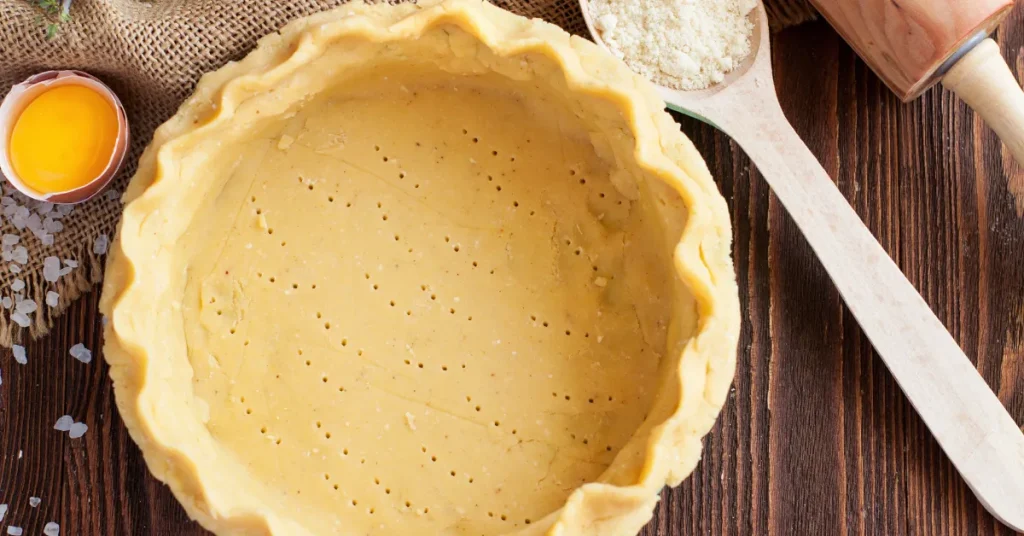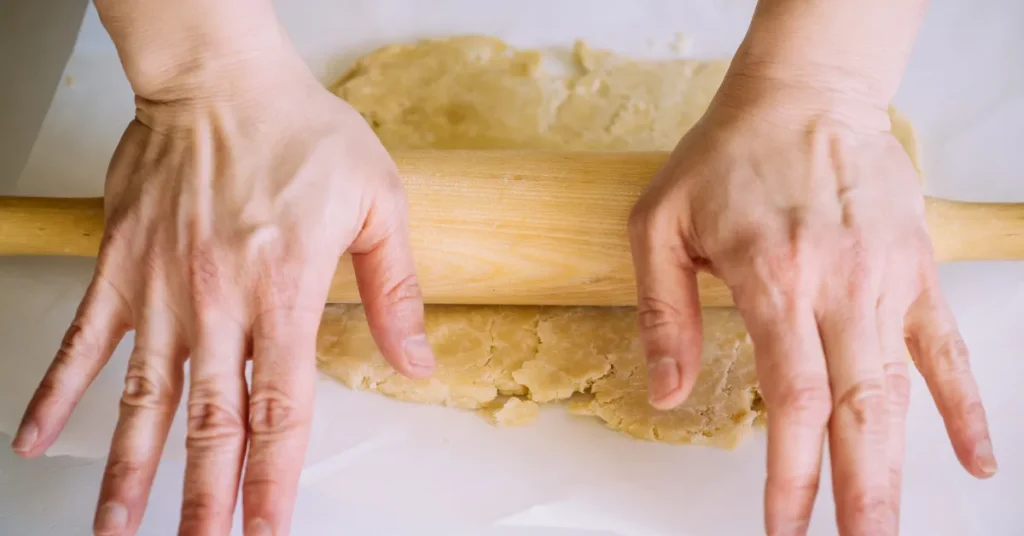A pie crust should ideally be about 1/8-inch (3 mm) thick. This thickness ensures the crust is sturdy enough to hold fillings while remaining flaky.
Delicious, homemade pies evoke a sense of comfort and nostalgia, making them a cherished dessert at any gathering. Achieving the perfect pie crust is the foundation of a great pie, and the thickness of the crust plays a crucial role in the pie’s overall texture and taste.
Thin enough to be delightfully crispy yet thick enough to not crumble under the weight of the filling, the crust serves as the delicious vessel for your chosen sweet or savory ingredients.
Bakers aim for uniform thickness to guarantee even cooking, prevent soggy bottoms, and ensure the edges don’t burn before the rest of the pie is perfectly baked.
Crafting a scrumptious pie starts with mastering the art of rolling your dough to just the right thickness.

The Art Of Pie Crust Perfection
Creating the perfect pie crust is a skill that bakers pride themselves on. The thickness of your pie crust plays a vital role in both flavor and function.
Too thick, and it can become chewy and heavy; too thin, and it might not support the weight of the filling. This guide will help you find the ideal balance for that golden, flaky outcome every time.
Balancing Texture And Durability
A pie crust must be durable enough to hold your filling while keeping a light and tender texture. Aim for a thickness of 1/8 to 1/4 inch. This range offers enough structure to support the filling without becoming tough.
- Roll evenly to avoid thin spots.
- The crust should be pliant but not elastic.
- Avoid overworking the dough to prevent toughness.
Visual Appeal: Thin Vs Thick
The crust’s thickness affects its appearance once baked. A thin crust is delicate and can be crisply elegant, but risks breaking. A thicker crust provides a hearty, rustic look, yet may seem doughy. Balance is key.
Follow these tips:
| Thickness | Visual | Notes |
| 1/8 inch | Fine and delicate | Great for tarts and quiches |
| 1/4 inch | Bold and rustic | Ideal for deep-dish pies |
Classic Pie Crust Thickness Standards

When making a pie, crust thickness is key to a perfect bake. Classic pie crust thickness standards serve as a guide for achieving that golden, flaky texture everyone loves.
Typical Measurements For Various Pie Types
Pie crust thickness can make or break your pie. For desserts that are just right, follow these measurements:
- Single Crust Pie: Roll dough to a thickness of 1/8 inch.
- Double Crust Pie: Each crust should also be 1/8 inch thick.
- Mini Pies: Keep crusts slightly thinner, about 1/16 inch.
Follow these measurements for a crust that’s golden and delicious. Use a ruler to check if you’re unsure. Achieving the perfect thickness promises a pie that’s both tasty and beautifully textured.
Regional And Culinary Influences
Pie crust preferences can vary around the world. Cultural tastes often dictate thickness standards.
In the United States, classic pies like apple or cherry generally stick to the 1/8 inch standard. But, British pies, like a hearty steak and kidney, may have heartier crusts that are up to 1/4 inch thick. French tarts, meanwhile, often sport a delicate, thinner crust.
Here’s a quick overview:
| Region/Cuisine | Preferred Pie Crust Thickness |
| United States (Dessert Pie) | 1/8 inch |
| United Kingdom (Savory Pie) | Up to 1/4 inch |
| France (Tart) | 1/16 to 1/8 inch |
Whether thin and crisp or thick and hearty, the crust is what makes a pie truly memorable. Keep these standards in mind, and your pies will stand out in any bake-off!
Parameters Influencing Pie Crust Thickness
Perfecting the pie crust is critical for a delicious pie. Many factors decide its thickness. Flavour, texture, and durability all hinge on how thick you roll your dough. Understand these culinary principles for the best results.
The Role Of Fillings In Determining Crust Density
Filling consistency affects crust thickness. Heavy or juicy fillings demand sturdier crusts. Here’s what to know:
- Fruit pies: Usually need thicker bottoms, around 1/8 to 1/4 inch, to prevent sogginess.
- Cream or chiffon pies: Lighter fillings require a thinner crust, often 1/8 inch, to complement the delicate texture.
- Quiche: With its custard base, it requires a crust just thick enough, about 1/8 inch, to support but not overwhelm.
Temperature And Baking Time Considerations
Temperature and time are interlinked with crust thickness. Observe these principles:
| Crust Thickness | Temperature | Time |
| Thin (1/8 inch) | Higher | Shorter |
| Thick (1/4 inch) | Lower | Longer |
Use these tips to adjust your baking approach:
- Preheat your oven accurately to ensure consistent results.
- Monitor baking closely; thin crusts can brown quickly.
- For thicker crusts, a longer, slower bake prevents undercooking.
Achieving the ideal crust thickness ensures your pie stands out. Consider these factors for a memorable bake every time.
Achieving The Perfect Thickness
Getting your pie crust just right is no small feat, and it all starts with the thickness. The perfect pie crust should be thick enough to support the filling without turning soggy and thin enough to deliver that satisfying crispiness with each bite.
Aim for a crust that’s about 1/8 to 1/4 inches thick. Not too thin, not too thick, but just right to hold its shape and melt in your mouth.
Techniques For Rolling Out Even Layers
Even layers are key to the perfect crust. Here’s how:
- Always start from the center of your dough.
- Roll outwards in different directions.
- Turn the dough a quarter after a few rolls.
- This prevents sticking and promotes uniform thickness.
- Try not to roll over the edges, this keeps them from becoming too thin.
Tools To Aid In Measuring And Consistency
Consistency is the secret to a stellar pie crust. Use these tools:
- Rolling pin with adjustable rings: Rings ensure equal thickness.
- Pastry mat with measurements: Easy guide for size.
- Pie crust shield: Prevents edges from overbrowning.
Use these tools to roll out dough with confidence, knowing your crust will be the perfect canvas for an array of delicious fillings.
Troubleshooting Common Pie Crust Issues

Troubleshooting common pie crust issues can turn pie-making from frustrating to fulfilling. Whether a recipe for sweet or savory pie, the crust serves as the foundation. Its thickness is critical.
A crust that’s too thick or too thin can ruin the perfect pie. By mastering a few key techniques, baking the ideal crust is within reach for any baker.
Preventing Soggy Bottoms With Optimal Thickness
Pie lovers dread a soggy bottom. A precisely rolled crust eliminates this issue. For a flaky and golden base, aim for a thickness of about 1/8 inch (3 mm). Here’s how:
- Start with cold dough to maintain butter bits that ensure flakiness.
- Roll out evenly, checking thickness with a ruler.
- Rotate the dough quarter-turns to achieve uniform thickness.
Extra Tip: Pre-baking or ‘blind-baking’ the crust for a few minutes creates a barrier, preventing sogginess from pie fillings.
Fixing Cracks And Breaks In Thin Crusts
Sometimes, a crust might roll out too thin, leading to cracks and breaks. Here’s a quick fix:
- Stay calm. Gather the broken pieces.
- Pinch cracks together or patch with spare dough.
- Chill the crust briefly to harden before baking.
A sparing dab of cold water smooths over patches and seals cracks.
Remember: It’s essential to handle the dough gently during these fixes to maintain a tender crust.
Savoring The Results
Savoring the results of a perfectly baked pie crust can transform a simple dessert into a memorable experience.
The meticulous attention to crust thickness plays a crucial role in creating that blissful first bite.
Pie enthusiasts often debate thickness preferences, searching for that golden mean between flaky layers and sturdy support for the filling.
Let’s explore how the thickness can alter your pie’s taste and texture to help you find your personal sweet spot.
Tasting The Difference: Experimentation And Preference
Exploring different crust thicknesses can lead to delightful discoveries in the kitchen. Pies are personal, and so is the journey to finding the ideal crust.
- Thin crusts: Crisp and delicate, they complement light fillings.
- Medium crusts: Offer a classic taste, balancing flakiness and durability.
- Thick crusts: Hearty and satisfying, they support denser toppings.
Conduct a taste test by preparing the same pie with various crust thicknesses. Note how each bite feels and record preferences. This practice helps you refine your pie craft and customize the experience to personal tastes.
The Final Verdict: Balancing Tradition And Taste
Traditional pie crust thickness sets a guideline, but personal taste always takes precedence. A consensus among seasoned bakers leans towards a crust that’s about 1/8 to 1/4 inches thick.
This range offers an ideal middle ground, with ample structural integrity and flaky texture in each bite.
Remember, the key lies in the harmony between the crust and the filling. Ensure that the thickness complements, rather than overpowers, the pie’s star flavors. Trust your palate and let taste be the guide to sculpting the ultimate pie crust.
Consider the following table to summarize traditional thickness standards for various pie types:
| Pie Type | Recommended Crust Thickness |
| Fruit Pie | 1/8 to 1/4 inches |
| Cream Pie | 1/4 inches |
| Quiche | 1/4 to 1/2 inches |
Experimentation and personal preference shape the ideal pie crust. Creating the perfect pie is an art—a dance between tradition and individual taste. Take these insights into your kitchen, and let the magic unfold with each roll of the dough.
FAQs About How Thick Should A Pie Crust Be
What Size Is A Standard Pie Crust?
A standard pie crust typically measures 9 inches in diameter.
What Is The Secret To A Good Pie Crust?
The secret to a good pie crust is keeping ingredients cold, using a mix of butter and shortening, and handling the dough minimally. Ensure proper fat distribution and bake at a high temperature for flakiness.
What Happens If Pie Crust Is Too Thin?
A too-thin pie crust can lead to breaks during baking and may result in a soggy bottom as it won’t support the filling adequately. It may also overcook, becoming too crispy or burn more easily than a thicker crust.
How Do You Measure The Thickness Of Dough?
Measure dough thickness using a rolling pin with adjustable rings, a ruler, or a pastry mat with measurement markings. For consistent results, ensure an even surface by rolling from the center outward.
Conclusion
Mastering the perfect pie crust thickness unlocks the secret to a delectable pie. Ideally, aim for about 1/8 inch for a balanced bake.
Remember, consistency is key to ensuring your crust holds its filling while providing that satisfying crunch. Keep practicing, and your pies will be the talk of any gathering!
Resources:
1. https://www.nps.gov/articles/000/army-pie-crust-recipe.htm
